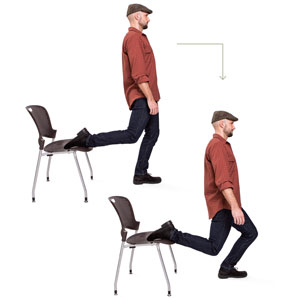
We know that being sedentary is harmful to our health—but working in an office may not give us a chance to move around as much as we would like. Along with several tips for workplace ergonomics, we offer simple, short exercises to get you up from your desk and moving in no time. Encourage your coworkers to join in!
Everyone’s familiar with the monkey-to-man evolution graphic, but what about the inverse? Sitting at a desk for hours on end can doom you to the chimplike workstation slouch. We need not lead a life of poor posture, though. Simple changes will have you walking taller in no time.
The price of doing business
Forward head posture, rounded shoulders, tight hip flexors and hamstrings, tired eyes, and frequent headaches. Sounds good … where do I sign up?
That’s probably the opposite of what you’re thinking. But you’ve already signed up if you work in an office and spend the majority of your day seated at a desk, staring at a computer monitor. A 2007 review of 25 studies found that sitting for more than half a workday, in concert with awkward postures, increases the likelihood of developing lower back pain and sciatica (pain along the sciatic nerve, which runs from the lower back down the legs).
A review of studies from 1996 to 2011 showed a consistent relationship between the number of hours people are seated throughout the day and mortality, as well as a connection to weight gain from childhood to adulthood. A Canadian study included in the review found a strong association between time spent sitting and mortality from cardiovascular disease and all causes. Basically, the longer people spend sitting, the worse their outcomes.
You’ve got to move it
There are ways to get up and move at work without altering your precious schedule:
- Use a standing desk.
- Schedule meetings to take place walking outdoors instead of in a boardroom.
- Take phone calls on a headset so you get in the habit of standing and walking any time your phone rings.
Mom says sit up straight!
You can also easily improve your posture:
- Adjust your computer monitor so the top line of text on the screen (not the top of the monitor) is at eye level.
- Zoom in, increasing your computer’s display percentage so you don’t have to lean forward and crane your neck.
- Tweak your keyboard height so you don’t have to shrug your shoulders and flex your wrists. Your wrists should be straight when your fingers are on the middle row of keys.
You can do these, no sweat
Ergonomic improvements and less sitting at your office will pay modest but almost immediate dividends; however, adding regular workstation exercises can make a world of difference. You may protest the potential for pie-plate sweat stains under your arms or how ridiculous you will look snapping off burpees at your desk. But the following exercises won’t make your co-workers believe you are a protein shake-drinking, rep-counting, card-carrying fitness cult member. Try these low-key, high-value exercises the next time you are feeling stressed and gnarled. For best results, complete every hour or two.
 Find a wall
Find a wall
Wall angels 1 set of 10 repetitions
Muscles worked: deltoids (all), abdominals
Muscles stretched: chest
- Stand with feet hip-width apart roughly half a metre away from an empty wall.
- Carefully lean back so your knees are bent and your back and head are flat against the wall.
- Push your lower back into the wall by activating and squeezing your abdominal muscles, and maintain this position throughout the exercise.
- Bring your arms up to shoulder height, with a 90-degree bend at your elbows.
- The backs of your hands, elbows, and shoulders should maintain contact with the wall at all times.
- Slowly slide your arms up the walls, reaching toward the ceiling as you straighten them overhead.
If at any point part of your arm, hand, or body starts to lift off the wall, pause there for a moment, take a breath, and slide your arms back down to starting position, at shoulder height.
 On your feet
On your feet
Hip flexor lunge 1 set of 5 per leg
Muscles worked: glutes, hamstrings, quadriceps
Muscles stretched: hip flexors, quadriceps, abdominals, tibiales anteriores
- If you have good balance, you can do this exercise free form, but if you are a little wobbly, you may want to use a hand to hold on to your desk.
- Stand with your back to your chair, roughly 1 metre in front of it.
- Take your right foot and place it on the chair, laces down, so the bottom of your foot faces the ceiling.
- While maintaining a tall upper body and leaning backward slightly, lightly push your hips forward while you relax your right knee and allow it to sink toward the ground until you feel a stretch in your quadriceps.
- After a brief pause, stand up and resume starting position.
 From your chair
From your chair
Alternating quadriceps extensions 1 set of 20 repetitions
Muscles worked: quadriceps, tibiales anteriores
Muscles stretched: calves, hamstrings
- Sit as tall as you can in your chair, feet flat on the floor, imagining a string running from the top of your head down to your tailbone.
- Without shifting your weight to your right, and without lifting your upper leg, point the toe of your left leg back toward the knee as much as possible while straightening your left leg.
- Your hip, knee, and ankle should all come close to being the same height when you have straightened your leg fully.
- After a brief pause, lower your foot to the starting position.
- Repeat the movement, alternating legs.

While Standing
Bow and reach 1 set of 8 repetitions
Muscles worked: hamstrings, glutes, lower back, posterior deltoids, abdominals
Muscles stretched: hamstrings, lower back, latissimus dorsi
- Begin with arms straight overhead, palms together. Stand as tall as you can be.
- Inhale through your nose in this position, and then exhale through your mouth, pushing your hips back and folding forward at the hips (keeping the arms in the same overhead position) until you make a 90-degree angle at the waist.
- Inhale through your nose in this position, and as you exhale, come back to starting position.
Ergo adjustments
Ergonomics is the science of fitting the job to the worker and the product to the user, according to the Canadian Centre for Occupational Health and Safety. The workplace is often the focal point of the study of ergonomics. After a workspace, and a worker’s interaction with the space, is observed, changes can be suggested that can improve posture and reduce strain from, for example, repetitive movements.




































